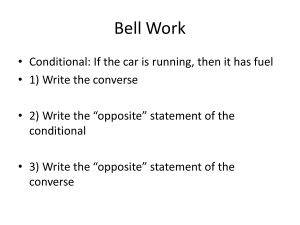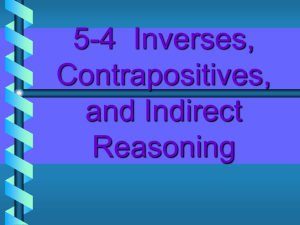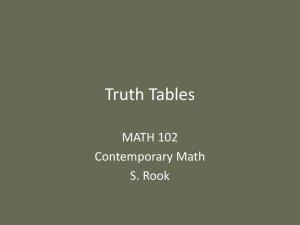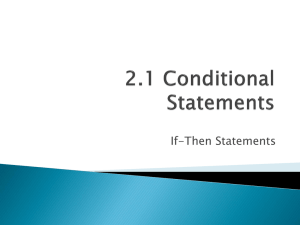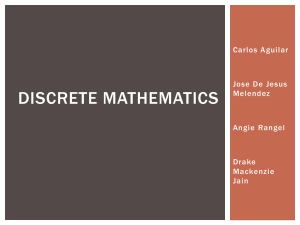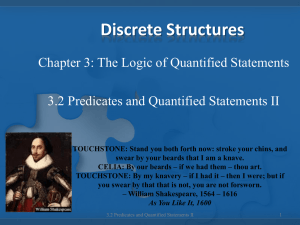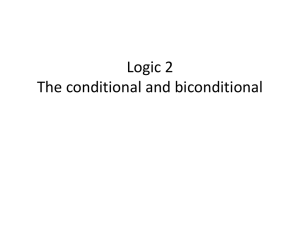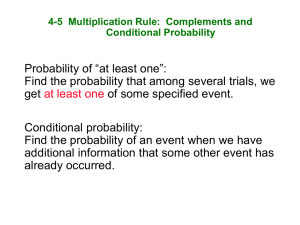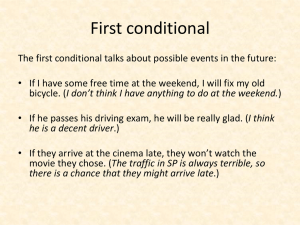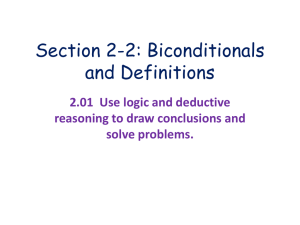ppt - People Server at UNCW
advertisement
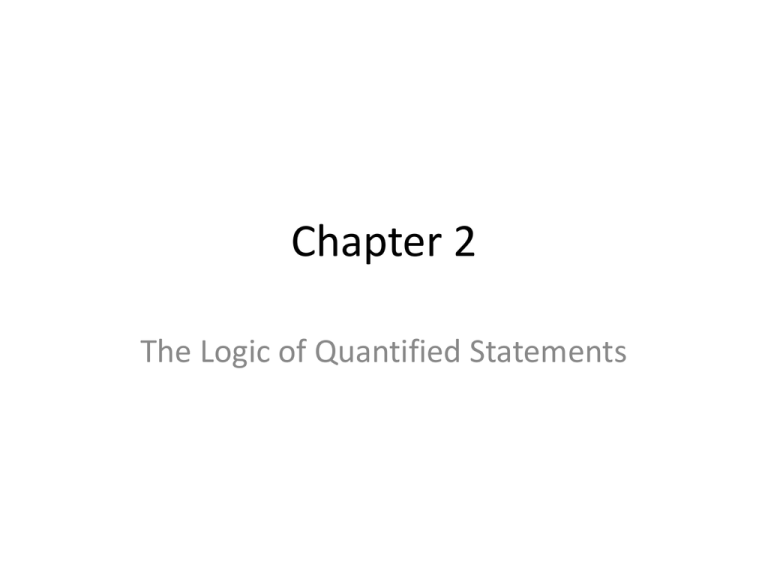
Chapter 2 The Logic of Quantified Statements Section 2.2 Intro to Predicates & Quantified Statements Negations of Quantified Statements • Negation of Universal Statement – example: “All computer scientist are nerds” • What is the negation of this statement? • What will make this universal statement false? • Recall: Universal statement is true, if and only if, all Q(x) is true for every x in (domain), so to make false? – False: “Some (one or more) computer scientist are not nerds.” Negations of Quantified Statements • Negation of Universal Statement – ∀x in D, Q(x) (universal statement) – ~(∀x in D, Q(x) ) ≡∃x ∈D such that ~Q(x) – The negation of a ∀ (“all are”) is logically equivalent to an ∃ (“some are not”). Negations of Quantified Statements • Negation of Existential Statement – ∃: “Some fish breathe air.” – ~∃: “Some fish do not breathe air.” • Same as the first statement. • Recall: Existential is defined to be true if, and only if, Q(x) is true for at least one x in D. – ~∃: “No fish breathe air.” Negations of Quantified Statements • Negation of Existential Statement – ∃x in D such that Q(x) (Existential Statement) – ~(∃x ∈D such that Q(x)) ≡ ∀x ∈D, ~Q(x) – The negation of an ∃ (“some are”) is logically equivalent to a ∀ (“all are not”) Example • Write formal negations for: – ∀ primes p, p is odd. – ~(∀ primes p, p is odd) ≡ ∃prime p, such that p is not odd) • predicate Q: is odd hence, ~Q: is not odd – ∃a triangle T such that the sum of the angles of T = 200˚ – ~(∃T ∈ triangles such that sum of the angles of T = 200˚) ≡∀triangles T, no sum of the angles of T = 200˚.) – Or, ∀triangles T, sum of the angles of T ≠ 200˚. Examples • Formal and informal: – No politicians are honest. – (formal) ∀politicians p, p is not honest – (formal negation) ∃a politician p, such that p is honest. – (informal negation) “Some politicians are honest.” Example • Informal negation – “Some professors are over 40” • Universal or existential statement? • predicate variable: professors. • predicate Q: “are over 40” • ~(∃x ∈D such that Q(x)) ≡ ∀x ∈D, ~Q(x) – “All professors are not over 40” – Or, “No professors are over 40” Negation of Universal Conditional Statement • ~(∀x, P(x) → Q(x)) ≡∃x such that ~(P(x) → Q(x)) • ~(P(x) → Q(x)) ≡ P(x) ^ ~Q(x) • so, – ~(∀x, P(x) → Q(x)) ≡∃x such that P(x) ^ ~Q(x) • Example: – “∀people x, if x is blond then x has blue eyes” • Predicates P “is blond” Q “has blue eyes” and variable x – Negation • “∃a person x such that x is blond and x does not have blue eyes” Vacuous Truth of Universal Statements • Vacuous truth of a universal statement occurs if one can show that the counterexample is false. • ∀x in D, if P(x) then Q(x) is true if and only if, P(x) is false for every x in D. Example Suppose there is bowl with 5-blue balls and 5-gray balls sitting next to it. If we placed 3-blue balls and 1-gray ball into the ball, the statement “All the balls in the ball are blue” is false. However if remove all the balls and ask the same statement, is it true or false? The statement is false if, and only if, its negation is true. The negation is “there exists a ball in the bowl that is not blue.” Since there are no balls in the bowl the negation is false, and hence, the statement “Al the balls in the ball are blue” is TRUE. Variants of Universal Conditional Statements • Universal conditional statement: – ∀x ∈ D, if P(x) then Q(x) – Contrapositive • ∀x ∈ D, if ~Q(x) then ~P(x) – Converse • ∀x ∈ D, if Q(x) then P(x) – Inverse • ∀x ∈ D, if ~P(x) then ~Q(x) Examples • Write the variants for the statement: – “If a real number is greater than 2, then its square is greater than 4” – (formal) ∀x ∈R, if x > 2 then x2 > 4 • Contrapositive – (formal) ∀x ∈R, if x2 ≤ 4 then x ≤ 2 – (informal) If the square of a real number ≤ 4, then the number ≤ 2 Examples • Converse – (formal) ∀x ∈R, if x2 > 4 then x > 2 – (informal) if the square of a real number > 4 then, the real number > 2. • Inverse – (formal) ∀x ∈R, if x ≤ 2 then x2 ≤ 4 – (informal) if the real number ≤ 2 then the square ≤ 4. Equivalence of Universal Conditional Statements • From conditional statements: – p → q ≡ ~q → ~p – conditional ≡ contrapositive • ∴, ∀x ∈D, if P(x) then Q(x) ≡∀x ∈D, if ~Q(x) then ~P(x) • Example – ∀x ∈R, if x > 2 then x2 > 4 ≡∀x ∈R, if x2 ≤ 4 then x ≤ 2 – Can you prove that this is not logically equivalent? Equivalence of Universal Conditional Statements • From conditional statements: – p→q≠q→p – conditional ≠ converse • ∴, ∀x ∈D, if P(x) then Q(x) ≠∀x ∈D, if Q(x) then P(x) • Example – ∀x ∈R, if x > 2 then x2 > 4 ??∀x ∈R, if x2 > 4 then x > 2 – Can you prove that this is logically equivalent? • the condition is true, however the converse is not. • Try x=-4, (-4)2 > 4 however -4 > 2 Equivalence of Universal Conditional Statements • From conditional statements: – p → q ≡ ~p → ~q – conditional ≠ inverse • ∴, ∀x ∈D, if P(x) then Q(x) ≠∀x ∈D, if ~P(x) then ~Q(x) • Example – ∀x ∈R, if x > 2 then x2 > 4 ??∀x ∈R, if x ≤ 2 then x2 ≤ 4 – Can you prove that this is logically equivalent? • the condition is true, however the inverse is not. • Try x=-4, -4 ≤ 2 however (-4)2 ~≤ 2 Necessary and Sufficient Conditions • “∀x, r(x) is a sufficient condition for s(x)” means ∀x if r(x) then s(x). • “∀x, r(x) is a necessary condition for s(x)” means ∀x if ~r(x) then ~s(x) or ∀x if s(x) then r(x). • “∀x, r(x) only if s(x)” means ∀x if ~s(x) then ~r(x). Example • Rewrite the statements as quantified conditional statements removing necessary and sufficient. – “Squareness is a sufficient condition for rectangularity.” – (formal) ∀x, if x is a square, then x is a rectangle – “Being at least 35 years old is a necessary condition for being President of USA” – (formal) ∀people p, p is President of USA, then p ≥ 35 years old

